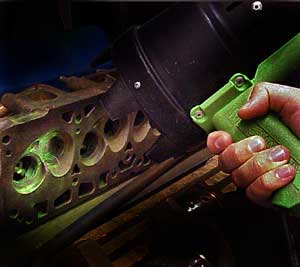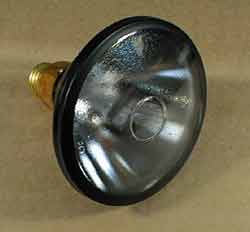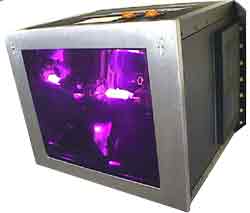Color Definitions of Particles Under Uv or Black Light Exposure
Lights for MPI
 Magnetic particle inspection can be performed using particles that are highly visible under white light conditions or particles that are highly visible under ultraviolet light conditions. When an inspection is being performed using the visible color contrast particles, no special lighting is required as long as the area of inspection is well lit. A light intensity of at least 1000 lux (100 fc) is recommended when visible particles are used, but a variety of light sources can be used.
Magnetic particle inspection can be performed using particles that are highly visible under white light conditions or particles that are highly visible under ultraviolet light conditions. When an inspection is being performed using the visible color contrast particles, no special lighting is required as long as the area of inspection is well lit. A light intensity of at least 1000 lux (100 fc) is recommended when visible particles are used, but a variety of light sources can be used.
When fluorescent particles are used, special ultraviolet light must be used. Fluorescence is defined as the property of emitting radiation as a result of and during exposure to radiation. Particles used in fluorescent magnetic particle inspections are coated with a material that produces light in the visible spectrum when exposed to near-ultraviolet light. This "particle glow" provides high contrast indications on the component anywhere particles collect. Particles that fluoresce yellow-green are most common because this color matches the peak sensitivity of the human eye under dark conditions. However, particles that fluoresce red, blue, yellow, and green colors are available. See Why Things Fluoresce to learn more about the physics of fluorescent particles.
Ultraviolet Light
Ultraviolet light or "black light" is light in the 1,000 to 4,000 Angstroms (100 to 400nm) wavelength range in the electromagnetic spectrum. It is a very energetic form of light that is invisible to the human eye. Wavelengths above 4,000A fall into the visible light spectrum and are seen as the color violet. UV is separated according to wavelength into three classes: A, B, and C. The shorter the wavelength, the more energy that is carried in the light and the more dangerous it is to the human cells.
| Class | Wavelength Range |
The desired wavelength range for use in nondestructive testing is between 3,500 and 3,800A with a peak wavelength at about 3,650A. This wavelength range is used because it is in the UV-A range, which is the safest to work with. UV-B will do an effective job of causing substances to fluoresce, however, it should not be used because harmful effects such as skin burns and eye damage can occur. This wavelength of radiation is found in the arc created during the welding process. UV-C (1,000 to 2,800A) is even more dangerous to living cells and is used to kill bacteria in industrial and medical settings.
The desired wavelength range for use in NDT is obtained by filtering the ultraviolet light generated by the light bulb. The output of a UV bulb spans a wide range of wavelengths. The short wavelengths of 3,120 to 3,340A are produced in low levels. A peak wavelength of 3650A is produced at a very high intensity. Wavelengths in the visible violet range (4050A to 4350A), green-yellow (5460A), yellow (6220A) and orange (6770A) are also usually produced. The filter allows only radiation in the range of 3200 to 4000A and a little visible dark purple to pass.
Basic Ultraviolet Lights
UV bulbs come in a variety of shapes and sizes. The more common types are the low pressure tube, high pressure spot, the high pressure flood types. The tubular black light is similar in construction to the tubular fluorescent lights used for office or home illumination. These lights use a low pressure mercury vapor arc. Tube lengths of 6 to 48 inches are common. The low pressure bulbs are most often used to provide general illumination to large areas rather than for illumination of components to be inspected. These bulbs generate a relatively large amount of white light, which is concerning since inspection specifications require less than two foot-candles of white light at the inspection surface.
 Flood lights are also used to illuminate the inspection area, since they provide even illumination over a large area. Intensity levels for flood lamps are relatively low because the energy is spread over a large area. They generally do not generate the required UV light intensity at the given distance that specifications require.
Flood lights are also used to illuminate the inspection area, since they provide even illumination over a large area. Intensity levels for flood lamps are relatively low because the energy is spread over a large area. They generally do not generate the required UV light intensity at the given distance that specifications require.
Spot lights, on the other hand, provide concentrated energy that can be directed to the area of inspection. A spot light will generate a six inch diameter circle of high intensity light when held fifteen inches from the inspection surface. One hundred watt mercury vapor lights are most commonly used, but higher wattages are available.
In the high pressure mercury vapor spot or flood lamps, UV light is generated by a quartz tube inside the bulb. This tube contains two electrodes that establish an arc. The distance between electrodes is such that a starting electrode must be used. A resister limits the current to the starting electrode that establishes the initial arc that vaporizes the mercury in the tube. Once this low level arc is established and the mercury is vaporized, the arc between the main electrodes is established. It takes approximately five minutes to "warm up" and establish the arc between the main electrodes. This is why specifications require a "warm up time" before using the high pressure mercury vapor lights. Flood and spot black lights produce large amounts of heat and should be handled with caution to prevent burns. This condition has been eliminated by newer designs that include cooling fans. The arc in the bulb can be upset when exposed to an external magnetic field, such as that generated by a coil. Care should be taken not to bring the lamp close to strong magnetic fields, but if the arc is upset and extinguished, it must be allowed to cool before it can be safely restarted.
High Intensity Ultraviolet Lights
 The 400 watt metal halide bulbs or "super lights" can be found in some facilities. This super bright light will provide adequate lighting over an area of up to ten times that covered by the 100 watt bulb. Due to their high intensity, excessive light reflecting from the surface of a component is a concern. Moving the light a greater distance from the inspection area will generally reduce this glare. Another type of high intensity light available is the micro-discharge light. This particular light produces up to ten times the amount of UV light conventional lights produce. Readings of up to 60,000 uW/cm2 at 15 inches can be achieved.
The 400 watt metal halide bulbs or "super lights" can be found in some facilities. This super bright light will provide adequate lighting over an area of up to ten times that covered by the 100 watt bulb. Due to their high intensity, excessive light reflecting from the surface of a component is a concern. Moving the light a greater distance from the inspection area will generally reduce this glare. Another type of high intensity light available is the micro-discharge light. This particular light produces up to ten times the amount of UV light conventional lights produce. Readings of up to 60,000 uW/cm2 at 15 inches can be achieved.
Color Definitions of Particles Under Uv or Black Light Exposure
Source: https://www.nde-ed.org/NDETechniques/MagParticle/Equipment/Lights.xhtml